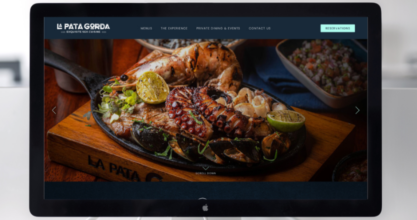The Digital Marketing dictionary: Core components
Digital marketing is a world of its own, and for many entrepreneurs, it can feel overwhelming to navigate. This is why we’ve created a short but complete dictionary with essential elements that every business owner should know. When it comes to Digital Marketing 101, having this list will give you a better understanding and foundation to build your strategies effectively. Here are the key terms and concepts to familiarize yourself with:
1. A/B Testing
Comparing two versions of a webpage or ad to determine which performs better is known as A/B testing. This method involves creating two variations and measuring their performance through metrics like click-through rates and conversions. The results guide data-driven decisions to optimize marketing strategies.
2. Analytics
Analytics, the name suggests, involves tracking and studying data from digital marketing efforts to measure performance. By examining metrics such as traffic sources, user behavior, and conversion rates, businesses can gain insights into how their strategies are performing.
3. B2B
B2B stands for Business-to-Business, referring to transactions between businesses. These businesses sell products or provide services to other companies rather than to individual consumers. B2B marketing strategies often focus on building relationships and demonstrating ROI to other businesses.
4. B2C
B2C stands for Business-to-Consumer, describing businesses that sell products or services directly to end-users. These companies target individual consumers with marketing strategies designed to address their personal needs and preferences. It often emphasizes emotional appeal and convenience.
5. Bounce Rate
In web analytics, bounce rate is the percentage of visitors who leave a website after viewing only one page. It indicates how effectively a site engages visitors and encourages them to explore further. In email marketing, this term refers to the percentage of undeliverable emails within a campaign, highlighting issues with email deliverability.
6. Call to Action (CTA)
A Call to Action (CTA) is a prompt that encourages users to take a specific action, such as “Book a Tour”, “Buy Now” or “Subscribe.” CTAs are designed to guide users toward completing a desired goal, whether it’s making a purchase or signing up for a newsletter. Effective CTAs are clear, compelling, and strategically placed.
7. Click-through Rate (CTR)
Click-through Rate (CTR) measures the average number of clicks per hundred ad impressions, expressed as a percentage. It calculates the effectiveness of online ads in driving user engagement and interest. A higher CTR indicates that an ad is successfully capturing the audience’s attention.
8. Conversion Funnel
This term outlines the journey users take from the initial awareness to completing a desired action, such as making a purchase. It includes stages such as awareness, consideration, and decision, each representing a step toward conversion.
9. Conversion Rate Optimization (CRO)
Conversion Rate Optimization (CRO) aims to maximize the return on marketing investments. It focuses on improving the effectiveness of web pages and marketing funnels. By analyzing user behavior and testing different elements, businesses can increase the percentage of visitors who complete desired actions.
10. Content Marketing
A very popular term in Digital Marketing 101 is content marketing. It involves creating and sharing valuable content such as blogs, videos, and infographics to attract, engage, and retain a target audience by providing relevant and useful information. Effective content marketing builds authority, trust, and brand loyalty.
11. Customer Relationship Management (CRM)
Customer Relationship Management (CRM) systems help manage and analyze customer interactions and data throughout the customer lifecycle. These systems are used to improve relationships, retention, and overall customer satisfaction.
12. Deep Linking
This refers to creating links that direct users to a specific page within a website, other than the home page. This practice enhances user navigation and improves access to relevant content. Deep links can drive targeted traffic and improve user engagement by linking to precise information.
13. Doorway Page
A doorway page is designed specifically to rank well for particular keywords in search engines. It serves as an entry point through which visitors are guided to more relevant content on a website. These pages are often used to manipulate search engine rankings but can negatively impact user experience.
14. Geo-Targeting
Geo-targeting involves detecting a website visitor’s location to deliver location-based content or advertisements. This method ensures that users receive relevant offers and information based on their geographic area. Geo-targeting improves the relevance of marketing messages and improves engagement.
15. Impression
A single instance of an online advertisement being displayed to a user. It represents the opportunity for an ad to be seen but does not guarantee interaction. Tracking impressions helps measure the reach and visibility of advertising campaigns.
16. Influencer Marketing
This strategy involves partnering with influential personalities to promote products or services. These influencers leverage their audience and credibility to enhance brand visibility and engagement.
17. Influencer Partnership
A collaboration with key figures in your industry that aims to boost brand credibility and extend reach to new potential customers. Effective partnerships often result in authentic endorsements and increased visibility.
18. Keyword Research
This process guides content creation and SEO strategies by focusing on relevant and high-traffic keywords. It involves identifying and analyzing keywords that potential customers use in search engines. Proper keyword research helps improve search engine rankings and attract targeted traffic.
19. Linkbait
Content created specifically to attract inbound links from other websites. The primary purpose is to generate high-quality backlinks that improve search engine rankings and drive referral traffic. Effective linkbait is engaging, valuable, and likely to be shared by other users.
20. Local Search
This strategy is essential for businesses that serve specific geographic areas. It focuses on enhancing visibility in search results for geographically relevant queries. Optimizing elements like Google My Business profiles and local content helps attract nearby customers.
21. Marketing Automation
Marketing automation involves using software to automate repetitive marketing tasks and workflows. It streamlines processes such as email campaigns, lead nurturing, and performance tracking. Automation helps improve efficiency and effectiveness by providing valuable insights and optimizing marketing efforts.
22. Metrics
This is a key term in Digital Marketing 101. It refers to quantitative measurements used to evaluate the performance of digital marketing activities. They include data points like engagement rates, conversion rates, and return on investment (ROI). Metrics guide strategic adjustments and help measure the success of marketing initiatives.
23. Mobile Optimization
This process involves adapting design elements and functionality to enhance user experience on smartphones and tablets. It ensures that websites and content are fully functional and visually appealing on mobile devices. Mobile optimization is crucial for accessibility and user satisfaction.
24. Organic Search
Unpaid entries on a search engine results page that appear based on content relevance to keyword queries. These results are driven by SEO efforts rather than paid advertisements. Achieving high rankings in organic search can increase visibility and drive targeted traffic.
25. Pay-per-Click (PPC)
An advertising model where advertisers pay a fee each time their ad is clicked. This method is used to drive targeted traffic to websites and measure ad performance through cost-per-click metrics. PPC campaigns can be managed on platforms like Google Ads and Bing Ads.
26. Retargeting
Retargeting involves showing targeted ads to users who have previously interacted with your website or content. This strategy aims to re-engage potential customers and encourage them to return and complete a desired action. Effective retargeting can significantly increase conversion rates.
27. Social Media Management
This strategy involves growing and maintaining your presence on platforms like Facebook and Instagram. This includes creating engaging posts, running ads, and interacting with followers. Effective social media strategies build relationships and foster community around your brand.
28. Social Proof
This means using customer reviews, testimonials, and case studies to build trust and credibility. By showcasing positive feedback and success stories, businesses demonstrate the value and effectiveness of their products or services. Social proof influences potential customers by validating brand claims.
29. User Experience (UX)
UX focuses on designing and optimizing digital interfaces to ensure a seamless and enjoyable user journey. It involves aspects like site navigation, usability, and overall satisfaction. A positive UX enhances engagement and encourages users to return.
30. Video Marketing
Leveraging video content such as demonstrations, testimonials, and live streams to engage audiences. This format enhances storytelling, captures attention, and improves conversion rates. Video marketing is effective across various platforms, providing dynamic and engaging content.
We hope that reading these terms provides you with a solid foundation in the core components of Digital Marketing 101. Naturally, mastering these elements requires experience, deep understanding, and years of knowledge. As a business owner, it’s best to entrust the application of these principles to a professional digital marketing agency in Coral Gables.



